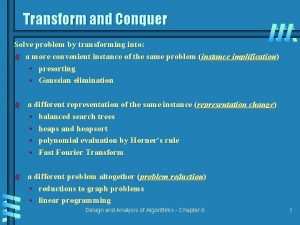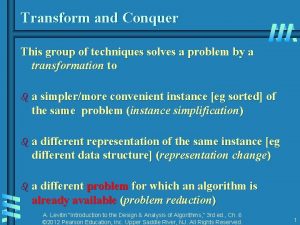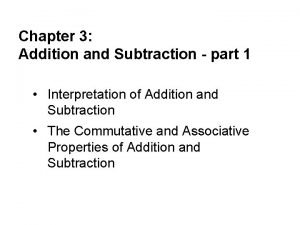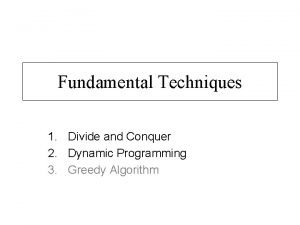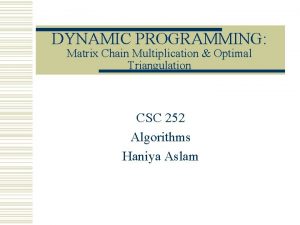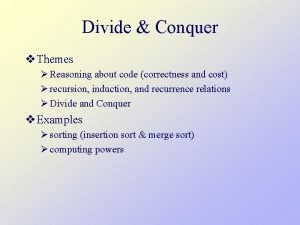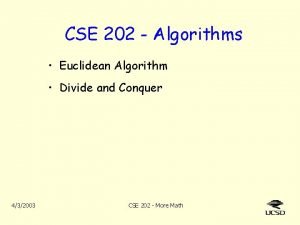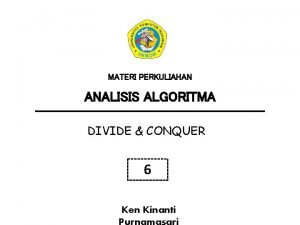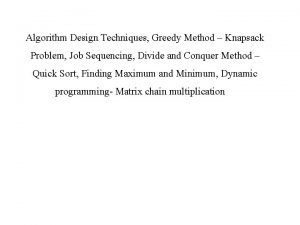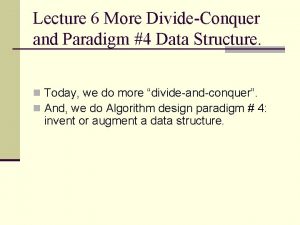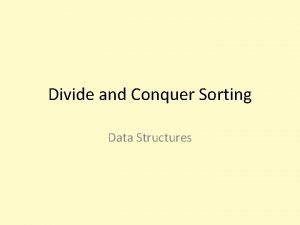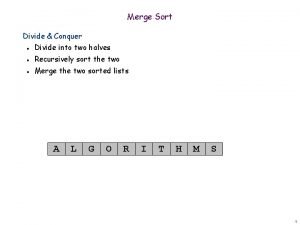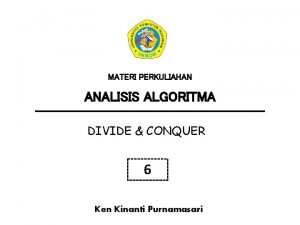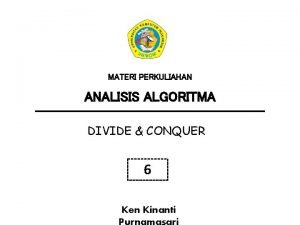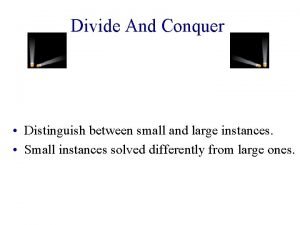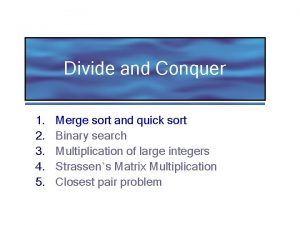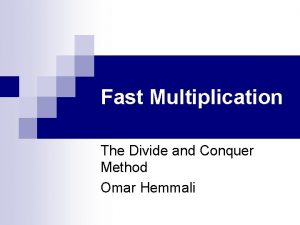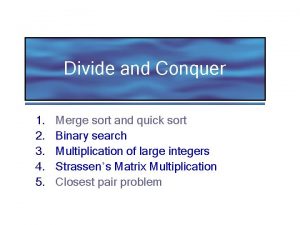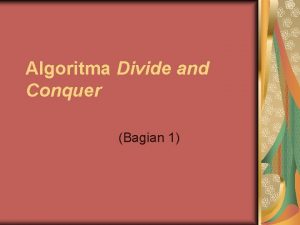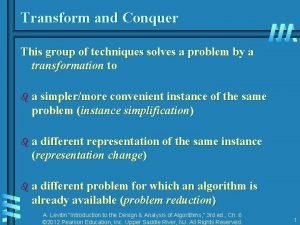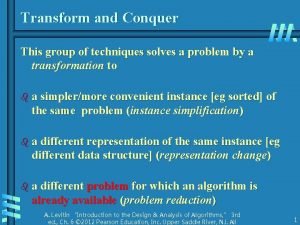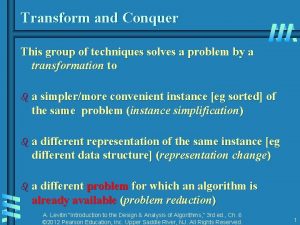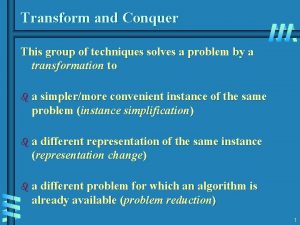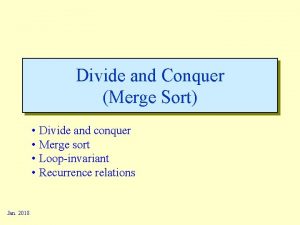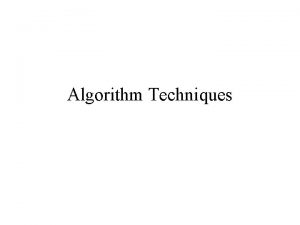Transform and Conquer This group of techniques solves



![Searching with presorting Problem: Search for a given K in A[0. . n-1] Presorting-based Searching with presorting Problem: Search for a given K in A[0. . n-1] Presorting-based](https://slidetodoc.com/presentation_image_h2/733f68e44f2ef5dbc274f3c247d95e29/image-4.jpg)











































- Slides: 47

Transform and Conquer This group of techniques solves a problem by a transformation to b a simpler/more convenient instance of the same problem (instance simplification) b a different representation of the same instance (representation change) b a different problem for which an algorithm is already available (problem reduction) A. Levitin “Introduction to the Design & Analysis of Algorithms, ” 3 rd ed. , Ch. 6 © 2012 Pearson Education, Inc. Upper Saddle River, NJ. All Rights Reserved. 1

Instance simplification - Presorting Solve a problem’s instance by transforming it into another simpler/easier instance of the same problem Presorting Many problems involving lists are easier when list is sorted, e. g. b searching b computing the median (selection problem) b checking if all elements are distinct (element uniqueness) Also: b Topological sorting helps solving some problems for dags. b Presorting is used in many geometric algorithms. A. Levitin “Introduction to the Design & Analysis of Algorithms, ” 3 rd ed. , Ch. 6 © 2012 Pearson Education, Inc. Upper Saddle River, NJ. All Rights Reserved. 2

How fast can we sort ? Efficiency of algorithms involving sorting depends on efficiency of sorting. Theorem (see Sec. 11. 2): log 2 n! n log 2 n comparisons are necessary in the worst case to sort a list of size n by any comparison-based algorithm. A. Levitin “Introduction to the Design & Analysis of Algorithms, ” 3 rd ed. , Ch. 6 © 2012 Pearson Education, Inc. Upper Saddle River, NJ. All Rights Reserved. 3
![Searching with presorting Problem Search for a given K in A0 n1 Presortingbased Searching with presorting Problem: Search for a given K in A[0. . n-1] Presorting-based](https://slidetodoc.com/presentation_image_h2/733f68e44f2ef5dbc274f3c247d95e29/image-4.jpg)
Searching with presorting Problem: Search for a given K in A[0. . n-1] Presorting-based algorithm: Stage 1 Sort the array by an efficient sorting algorithm Stage 2 Apply binary search Efficiency: Θ(nlog n) + O(log n) = Θ(nlog n) Good or bad? Why do we have our dictionaries, telephone directories, etc. sorted? A. Levitin “Introduction to the Design & Analysis of Algorithms, ” 3 rd ed. , Ch. 6 © 2012 Pearson Education, Inc. Upper Saddle River, NJ. All Rights Reserved. 4

Element Uniqueness with presorting b Brute force algorithm Compare all pairs of elements for n iterations Efficiency: O(n 2) A. Levitin “Introduction to the Design & Analysis of Algorithms, ” 3 rd ed. , Ch. 6 © 2012 Pearson Education, Inc. Upper Saddle River, NJ. All Rights Reserved. 5

Element Uniqueness with presorting b Presorting-based algorithm Stage 1: sort by efficient sorting algorithm (e. g. mergesort) Stage 2: scan array to check pairs of adjacent elements Efficiency: Θ(nlog n) + O(n) = Θ(nlog n) A. Levitin “Introduction to the Design & Analysis of Algorithms, ” 3 rd ed. , Ch. 6 © 2012 Pearson Education, Inc. Upper Saddle River, NJ. All Rights Reserved. 6

Computing a mode with presorting b A mode is a value that occurs most often in a given list of numbers. • For 5, 1, 5, 7, 6, 5, 7, the mode is 5. b Brute force algorithm Scan the list and compute the frequencies of all its distinct values Efficiency: O(n 2) A. Levitin “Introduction to the Design & Analysis of Algorithms, ” 3 rd ed. , Ch. 6 © 2012 Pearson Education, Inc. Upper Saddle River, NJ. All Rights Reserved. 7

Computing a mode with presorting b Presorting-based algorithm Stage 1: sort by efficient sorting algorithm (e. g. mergesort) Stage 2: scan array to check longest run of adjacent equal values Efficiency: Θ(nlog n) + O(n) = Θ(nlog n) A. Levitin “Introduction to the Design & Analysis of Algorithms, ” 3 rd ed. , Ch. 6 © 2012 Pearson Education, Inc. Upper Saddle River, NJ. All Rights Reserved. 8

Instance simplification – Gaussian Elimination Given: A system of n linear equations in n unknowns with an arbitrary coefficient matrix. Transform to: An equivalent system of n linear equations in n unknowns with an upper triangular coefficient matrix. Solve the latter by substitutions starting with the last equation and moving up to the first one. a 11 x 1 + a 12 x 2 + … + a 1 nxn = b 1 a 21 x 1 + a 22 x 2 + … + a 2 nxn = b 2 a 1, 1 x 1+ a 12 x 2 + … + a 1 nxn = b 1 a 22 x 2 + … + a 2 nxn = b 2 an 1 x 1 + an 2 x 2 + … + annxn = bn A. Levitin “Introduction to the Design & Analysis of Algorithms, ” 3 rd ed. , Ch. 6 © 2012 Pearson Education, Inc. Upper Saddle River, NJ. All Rights Reserved. annxn = bn

Gaussian Elimination A. Levitin “Introduction to the Design & Analysis of Algorithms, ” 3 rd ed. , Ch. 6 © 2012 Pearson Education, Inc. Upper Saddle River, NJ. All Rights Reserved. 10

Example of Gaussian Elimination Solve 2 x 1 - 4 x 2 3 x 1 - x 2 x 1 + x 2 + x 3 = 6 + x 3 = 11 - x 3 = -3 Gaussian elimination 2 -4 1 6 3 -1 1 11 row 2 – (3/2)*row 1 0 5 -1/2 2 1 1 -1 -3 row 3 – (1/2)*row 1 0 3 -3/2 -6 row 3–(3/5)*row 2 2 0 0 -4 1 6 5 -1/2 2 0 -6/5 -36/5 Backward substitution x 3 = (-36/5) / (-6/5) = 6 x 2 = (2+(1/2)*6) / 5 = 1 x = (6 – 6 + 4*1)/2 = 2 A. Levitin “Introduction to the Design & Analysis of 1 Algorithms, ” 3 rd ed. , Ch. 6 © 2012 Pearson Education, Inc. Upper Saddle River, NJ. All Rights Reserved.

Gaussian Elimination (cont. ) The transformation is accomplished by a sequence of elementary operations on the system’s coefficient matrix (which don’t change the system’s solution): for i ← 1 to n-1 do replace each of the subsequent rows (i. e. , rows i+1, …, n) by a difference between that row and an appropriate multiple of the i-th row to make the new coefficient in the i-th column of that row 0 A. Levitin “Introduction to the Design & Analysis of Algorithms, ” 3 rd ed. , Ch. 6 © 2012 Pearson Education, Inc. Upper Saddle River, NJ. All Rights Reserved.

Pseudocode and Efficiency of Gaussian Elimination Stage 1: Reduction to an upper-triangular matrix for i ← 1 to n-1 do for j ← i+1 to n do for k ← i to n+1 do A[j, k] ← A[j, k] - A[i, k] * A[j, i] / A[i, i] Stage 2: Back substitutions for j ← n downto 1 do t← 0 for k ← j +1 to n do t ← t + A[j, k] * x[k] x[j] ← (A[j, n+1] - t) / A[j, j] Efficiency: Θ(n 3) + Θ(n 2) = Θ(n 3) A. Levitin “Introduction to the Design & Analysis of Algorithms, ” 3 rd ed. , Ch. 6 © 2012 Pearson Education, Inc. Upper Saddle River, NJ. All Rights Reserved.

Searching Problem: Given a (multi)set S of keys and a search key K, find an occurrence of K in S, if any b Searching must be considered in the context of: • file size • dynamics of data b Dictionary operations (dynamic data): • find (search) • insert • delete A. Levitin “Introduction to the Design & Analysis of Algorithms, ” 3 rd ed. , Ch. 6 © 2012 Pearson Education, Inc. Upper Saddle River, NJ. All Rights Reserved. 14

Taxonomy of Searching Algorithms b List searching • sequential search • binary search b Tree searching • binary search tree • binary balanced trees: AVL trees, red-black trees • multiway balanced trees: 2 -3 trees, 2 -3 -4 trees, B trees b Hashing • open hashing (separate chaining) • closed hashing (open addressing) A. Levitin “Introduction to the Design & Analysis of Algorithms, ” 3 rd ed. , Ch. 6 © 2012 Pearson Education, Inc. Upper Saddle River, NJ. All Rights Reserved. 15

Binary Search Tree Arrange keys in a binary tree with the binary search tree property: K <K >K Example: 5, 3, 1, 10, 12, 7, 9 A. Levitin “Introduction to the Design & Analysis of Algorithms, ” 3 rd ed. , Ch. 6 © 2012 Pearson Education, Inc. Upper Saddle River, NJ. All Rights Reserved. 16

Dictionary Operations on Binary Search Trees Searching – straightforward Insertion – search for key, insert at leaf where search terminated Deletion – 3 cases: deleting key at a leaf deleting key at node with single child deleting key at node with two children Efficiency depends of the tree’s height: log 2 n h n-1, with height average (random files) be about 3 log 2 n Thus all three operations have • worst case efficiency: (n) • average case efficiency: (log n) Bonus: inorder traversal produces sorted list A. Levitin “Introduction to the Design & Analysis of Algorithms, ” 3 rd ed. , Ch. 6 © 2012 Pearson Education, Inc. Upper Saddle River, NJ. All Rights Reserved. 17

Balanced Search Trees Attractiveness of binary search tree is marred by the bad (linear) worst-case efficiency. Two ideas to overcome it are: b to rebalance binary search tree when a new insertion makes the tree “too unbalanced” • AVL trees • red-black trees b to allow more than one key per node of a search tree • 2 -3 trees • 2 -3 -4 trees • B-trees A. Levitin “Introduction to the Design & Analysis of Algorithms, ” 3 rd ed. , Ch. 6 © 2012 Pearson Education, Inc. Upper Saddle River, NJ. All Rights Reserved. 18

Balanced trees: AVL trees Definition An AVL tree is a binary search tree in which, for every node, the difference between the heights of its left and right subtrees, called the balance factor, is at most 1 (with the height of an empty tree defined as -1) Tree (a) is an AVL tree; tree (b) is not an AVL tree A. Levitin “Introduction to the Design & Analysis of Algorithms, ” 3 rd ed. , Ch. 6 © 2012 Pearson Education, Inc. Upper Saddle River, NJ. All Rights Reserved. 19

Rotations If a key insertion violates the balance requirement at some node, the subtree rooted at that node is transformed via one of the four rotations. (The rotation is always performed for a subtree rooted at an “unbalanced” node closest to the new leaf. ) Single R-rotation Single L-rotation Double LR-rotation Double RL-rotation A. Levitin “Introduction to the Design & Analysis of Algorithms, ” 3 rd ed. , Ch. 6 © 2012 Pearson Education, Inc. Upper Saddle River, NJ. All Rights Reserved. 20

General case: Single R-rotation A. Levitin “Introduction to the Design & Analysis of Algorithms, ” 3 rd ed. , Ch. 6 © 2012 Pearson Education, Inc. Upper Saddle River, NJ. All Rights Reserved. 21

General case: Double LR-rotation A. Levitin “Introduction to the Design & Analysis of Algorithms, ” 3 rd ed. , Ch. 6 © 2012 Pearson Education, Inc. Upper Saddle River, NJ. All Rights Reserved. 22

AVL tree construction - an example Construct an AVL tree for the list 5, 6, 8, 3, 2, 4, 7 A. Levitin “Introduction to the Design & Analysis of Algorithms, ” 3 rd ed. , Ch. 6 © 2012 Pearson Education, Inc. Upper Saddle River, NJ. All Rights Reserved. 23

AVL tree construction - an example (cont. ) A. Levitin “Introduction to the Design & Analysis of Algorithms, ” 3 rd ed. , Ch. 6 © 2012 Pearson Education, Inc. Upper Saddle River, NJ. All Rights Reserved. 24

Analysis of AVL trees b h 1. 4404 log 2 (n + 2) - 1. 3277 average height: 1. 01 log 2 n + 0. 1 for large n (found empirically) b Search and insertion are O(log n) b Deletion is more complicated but is also O(log n) b Disadvantages: • frequent rotations • complexity b A similar idea: red-black trees (height of subtrees is allowed to differ by up to a factor of 2) A. Levitin “Introduction to the Design & Analysis of Algorithms, ” 3 rd ed. , Ch. 6 © 2012 Pearson Education, Inc. Upper Saddle River, NJ. All Rights Reserved. 25

Multiway Search Trees Definition A multiway search tree is a search tree that allows more than one key in the same node of the tree. Definition A node of a search tree is called an n-node if it contains n-1 ordered keys (which divide the entire key range into n intervals pointed to by the node’s n links to its children): k 1 < k 2 < … < kn-1 < k 1 [k 1, k 2 ) kn-1 Note: Every node in a classical binary search tree is a 2 -node A. Levitin “Introduction to the Design & Analysis of Algorithms, ” 3 rd ed. , Ch. 6 © 2012 Pearson Education, Inc. Upper Saddle River, NJ. All Rights Reserved. 26

2 -3 Tree Definition A 2 -3 tree is a search tree that b may have 2 -nodes and 3 -nodes b height-balanced (all leaves are on the same level) A 2 -3 tree is constructed by successive insertions of keys given, with a new key always inserted into a leaf of the tree. If the leaf is a 3 -node, it’s split into two with the middle key promoted to the parent. A. Levitin “Introduction to the Design & Analysis of Algorithms, ” 3 rd ed. , Ch. 6 © 2012 Pearson Education, Inc. Upper Saddle River, NJ. All Rights Reserved. 27

2 -3 tree construction – an example Construct a 2 -3 tree the list 9, 5, 8, 3, 2, 4, 7 A. Levitin “Introduction to the Design & Analysis of Algorithms, ” 3 rd ed. , Ch. 6 © 2012 Pearson Education, Inc. Upper Saddle River, NJ. All Rights Reserved. 28

Analysis of 2 -3 trees b log 3 (n + 1) - 1 h log 2 (n + 1) - 1 b Search, insertion, and deletion are in (log n) b The idea of 2 -3 tree can be generalized by allowing more keys per node • 2 -3 -4 trees • B-trees A. Levitin “Introduction to the Design & Analysis of Algorithms, ” 3 rd ed. , Ch. 6 © 2012 Pearson Education, Inc. Upper Saddle River, NJ. All Rights Reserved. 29

Heaps and Heapsort Definition A heap is a complete binary tree with keys at its b b nodes (one key per node) such that: It is essentially complete, i. e. , all its levels are full except possibly the last level, where only some rightmost keys may be missing The key at each node is ≥ keys at its children A. Levitin “Introduction to the Design & Analysis of Algorithms, ” 3 rd ed. , Ch. 6 © 2012 Pearson Education, Inc. Upper Saddle River, NJ. All Rights Reserved. 30

Illustration of the heap’s definition a heap not a heap Note: Heap’s elements are ordered top down (along any path down from its root), but they are not ordered left to right A. Levitin “Introduction to the Design & Analysis of Algorithms, ” 3 rd ed. , Ch. 6 © 2012 Pearson Education, Inc. Upper Saddle River, NJ. All Rights Reserved. 31

Some Important Properties of a Heap b Given n, there exists a unique binary tree with n nodes that is essentially complete, with h = log 2 n b The root contains the largest key b The subtree rooted at any node of a heap is also a heap b A heap can be represented as an array A. Levitin “Introduction to the Design & Analysis of Algorithms, ” 3 rd ed. , Ch. 6 © 2012 Pearson Education, Inc. Upper Saddle River, NJ. All Rights Reserved. 32

Heap’s Array Representation Store heap’s elements in an array (whose elements indexed, for convenience, 1 to n) in top-down left-to-right order Example: 9 1 2 3 4 5 6 5 1 b b 3 4 9 5 3 1 4 2 2 Left child of node j is at 2 j Right child of node j is at 2 j+1 Parent of node j is at j/2 Parental nodes are represented in the first n/2 locations A. Levitin “Introduction to the Design & Analysis of Algorithms, ” 3 rd ed. , Ch. 6 © 2012 Pearson Education, Inc. Upper Saddle River, NJ. All Rights Reserved. 33

Heap Construction (bottom-up) Step 0: Initialize the structure with keys in the order given Step 1: Starting with the last (rightmost) parental node, fix the heap rooted at it, if it doesn’t satisfy the heap condition: keep exchanging it with its largest child until the heap condition holds Step 2: Repeat Step 1 for the preceding parental node A. Levitin “Introduction to the Design & Analysis of Algorithms, ” 3 rd ed. , Ch. 6 © 2012 Pearson Education, Inc. Upper Saddle River, NJ. All Rights Reserved. 34

Example of Heap Construction Construct a heap for the list 2, 9, 7, 6, 5, 8 A. Levitin “Introduction to the Design & Analysis of Algorithms, ” 3 rd ed. , Ch. 6 © 2012 Pearson Education, Inc. Upper Saddle River, NJ. All Rights Reserved. 35

Pseudopodia of bottom-up heap construction A. Levitin “Introduction to the Design & Analysis of Algorithms, ” 3 rd ed. , Ch. 6 © 2012 Pearson Education, Inc. Upper Saddle River, NJ. All Rights Reserved. 36

Heap Construction (top-down) b b b Successive insert the new element at last position in heap. Compare it with its parent and, if it violates heap condition, exchange them Continue comparing the new element with nodes up the tree until the heap condition is satisfied Example: Insert key 10 Efficiency: O(log n) A. Levitin “Introduction to the Design & Analysis of Algorithms, ” 3 rd ed. , Ch. 6 © 2012 Pearson Education, Inc. Upper Saddle River, NJ. All Rights Reserved. 37

Maximum Key Deletion Step 1: Exchange the root’s key with the last key K of the heap Step 2: Decrease the heap’s size by 1 Step 3: Heapify the smaller sized tree by shifting K down the tree in the same way of bottom-up heap construction A. Levitin “Introduction to the Design & Analysis of Algorithms, ” 3 rd ed. , Ch. 6 © 2012 Pearson Education, Inc. Upper Saddle River, NJ. All Rights Reserved. 38

Heapsort Stage 1: Construct a heap for a given list of n keys Stage 2: Repeat operation of root removal (maximum key deletion) n-1 times: – Exchange keys in the root and in the last (rightmost) leaf – Decrease heap size by 1 – If necessary, swap new root with larger child until the heap condition holds A. Levitin “Introduction to the Design & Analysis of Algorithms, ” 3 rd ed. , Ch. 6 © 2012 Pearson Education, Inc. Upper Saddle River, NJ. All Rights Reserved. 39

Example of Sorting by Heapsort Sort the list 2, 9, 7, 6, 5, 8 by heapsort Stage 1 (heap construction) 2 9 7 6 5 8 2 9 8 6 5 7 9 2 8 6 5 7 9 6 8 2 5 7 Stage 2 (root/max removal) 9 6 8 2 5 7 7 6 8 2 5|9 8 6 7 2 5|9 5 6 7 2|8 9 7 6 5 2|8 9 2 6 5|7 8 9 6 2 5|7 8 9 5 2|6 7 8 9 2|5 6 7 8 9 A. Levitin “Introduction to the Design & Analysis of Algorithms, ” 3 rd ed. , Ch. 6 © 2012 Pearson Education, Inc. Upper Saddle River, NJ. All Rights Reserved. 40

Analysis of Heapsort b h-1 2(h-i) = 2(h-i) 2 i i=0 level i keys i=0 = 2 ( n – log 2(n + 1)) (n) n-1 2 log 2 i (nlogn) i=1 A. Levitin “Introduction to the Design & Analysis of Algorithms, ” 3 rd ed. , Ch. 6 © 2012 Pearson Education, Inc. Upper Saddle River, NJ. All Rights Reserved. 41

Priority Queue A priority queue is the ADT of a set of elements with numerical priorities with the following operations: • find element with highest priority • delete element with highest priority • insert element with assigned priority b Heap is a very efficient way for implementing priority queues A. Levitin “Introduction to the Design & Analysis of Algorithms, ” 3 rd ed. , Ch. 6 © 2012 Pearson Education, Inc. Upper Saddle River, NJ. All Rights Reserved. 42

Problem Reduction This variation of transform-and-conquer solves a problem by a transforming it into different problem for which an algorithm is already available. To be of practical value, the combined time of the transformation and solving the other problem should be smaller than solving the problem as given by another method. A. Levitin “Introduction to the Design & Analysis of Algorithms, ” 3 rd ed. , Ch. 6 © 2012 Pearson Education, Inc. Upper Saddle River, NJ. All Rights Reserved. 43

Examples of Solving Problems by Reduction b computing lcm(m, n) via computing gcd(m, n) b counting number of paths of length n in a graph by raising the graph’s adjacency matrix to the n-th power b transforming a maximization problem to a minimization problem and vice versa (also, min-heap construction) A. Levitin “Introduction to the Design & Analysis of Algorithms, ” 3 rd ed. , Ch. 6 © 2012 Pearson Education, Inc. Upper Saddle River, NJ. All Rights Reserved. 44

Computing the Least Common Multiple b A. Levitin “Introduction to the Design & Analysis of Algorithms, ” 3 rd ed. , Ch. 6 © 2012 Pearson Education, Inc. Upper Saddle River, NJ. All Rights Reserved. 45

Counting Paths in a Graph b Counting number of paths of length n in a graph by raising the graph’s adjacency matrix to the n-th power b Example: Three paths of length 2 that start and end at vertex a: a – b- a, a – c – a, a – d – a Only one path of length 2 from a to c: a – d - c A. Levitin “Introduction to the Design & Analysis of Algorithms, ” 3 rd ed. , Ch. 6 © 2012 Pearson Education, Inc. Upper Saddle River, NJ. All Rights Reserved. 46

Optimization Problem b Transforming a maximization problem to a minimization problem and vice versa (also, min-heap construction) b Example: min f(x) = - max[-f(x)] A. Levitin “Introduction to the Design & Analysis of Algorithms, ” 3 rd ed. , Ch. 6 © 2012 Pearson Education, Inc. Upper Saddle River, NJ. All Rights Reserved. 47
 Transform and conquer algorithm example
Transform and conquer algorithm example Priority queue using avl tree
Priority queue using avl tree Transform and conquer algorithm
Transform and conquer algorithm Discrete wavelet transform 이란
Discrete wavelet transform 이란 Jesus solves problems
Jesus solves problems Matteo is 4 feet 3 inches tall
Matteo is 4 feet 3 inches tall Divide and conquer advantages and disadvantages
Divide and conquer advantages and disadvantages Divide and conquer vs greedy
Divide and conquer vs greedy Delaunay triangulation divide and conquer algorithm
Delaunay triangulation divide and conquer algorithm The expression is a
The expression is a Delaunay triangulation divide and conquer algorithm
Delaunay triangulation divide and conquer algorithm Counting inversions divide and conquer
Counting inversions divide and conquer Divide et impera c++
Divide et impera c++ Dynamic programming bottom up
Dynamic programming bottom up Dynamic programming vs divide and conquer
Dynamic programming vs divide and conquer Divide and conquer
Divide and conquer Divide and conquer algorithm
Divide and conquer algorithm Let's divide and conquer
Let's divide and conquer Decrease and conquer
Decrease and conquer Cse 202
Cse 202 How to divide in pseudocode
How to divide in pseudocode Contoh algoritma divide and conquer
Contoh algoritma divide and conquer Divide should ideas prevail
Divide should ideas prevail Divide and conquer algorithm
Divide and conquer algorithm Divide and conquer algoritma
Divide and conquer algoritma Knapsack problem divide and conquer
Knapsack problem divide and conquer Foyer inn form hay shun gibberish
Foyer inn form hay shun gibberish Powering a number divide and conquer
Powering a number divide and conquer Is shell sort divide and conquer
Is shell sort divide and conquer Conquer termites northside
Conquer termites northside Index of soorma
Index of soorma Divide and conquer complexity
Divide and conquer complexity Divide and conquer
Divide and conquer Divide & conquer
Divide & conquer Tuliskan algoritma divide and conquer
Tuliskan algoritma divide and conquer Divide and conquer
Divide and conquer Divide and conquer
Divide and conquer Divide and conquer
Divide and conquer Application of divide and conquer
Application of divide and conquer Steps of divide and conquer approach *
Steps of divide and conquer approach * Digital divide and conquer
Digital divide and conquer Eras in texas history
Eras in texas history Multiplication divide and conquer
Multiplication divide and conquer Algoritma divide and conquer
Algoritma divide and conquer Divide and conquer
Divide and conquer Divide and conquer counting inversions
Divide and conquer counting inversions Penerapan algoritma divide and conquer
Penerapan algoritma divide and conquer Fonctions techniques
Fonctions techniques
